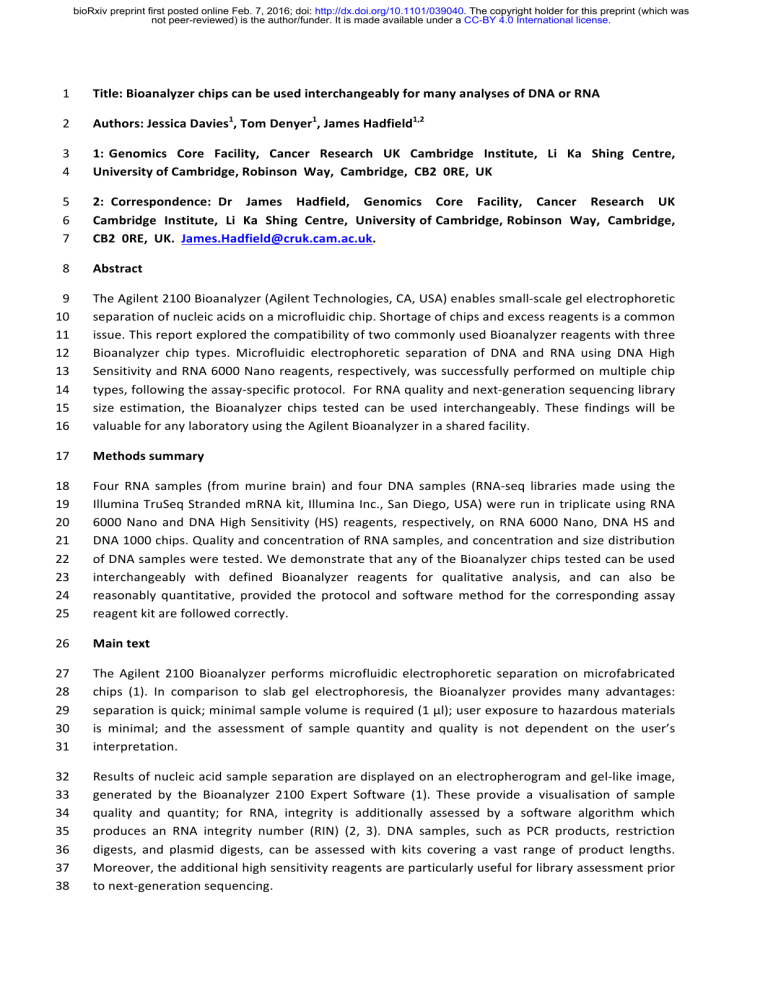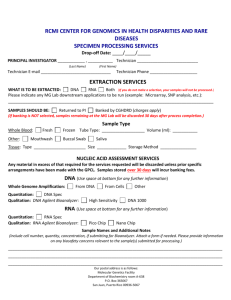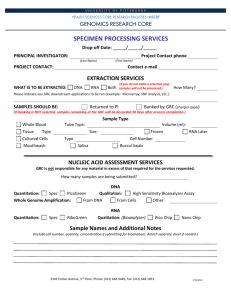Bioanalyzer chips can be used interchangeably for many

bioRxiv preprint first posted online Feb. 7, 2016; doi: http://dx.doi.org/10.1101/039040 not peer-reviewed) is the author/funder. It is made available under a
. The copyright holder for this preprint (which was
CC-BY 4.0 International license .
32
33
34
35
36
37
38
27
28
29
30
31
17
18
19
20
21
22
23
24
25
26
5
6
7
3
4
8
9
10
11
12
13
14
15
16
1
2
Title: Bioanalyzer chips can be used interchangeably for many analyses of DNA or RNA
Authors: Jessica Davies 1 , Tom Denyer 1 , James Hadfield 1,2
1: Genomics Core Facility, Cancer Research UK Cambridge Institute, Li Ka Shing Centre,
University of Cambridge, Robinson Way, Cambridge, CB2 0RE, UK
2: Correspondence: Dr James Hadfield, Genomics Core Facility, Cancer Research UK
Cambridge Institute, Li Ka Shing Centre, University of Cambridge, Robinson Way, Cambridge,
CB2 0RE, UK. James.Hadfield@cruk.cam.ac.uk
.
Abstract
The Agilent 2100 Bioanalyzer (Agilent Technologies, CA, USA) enables small-‐scale gel electrophoretic separation of nucleic acids on a microfluidic chip. Shortage of chips and excess reagents is a common issue. This report explored the compatibility of two commonly used Bioanalyzer reagents with three
Bioanalyzer chip types. Microfluidic electrophoretic separation of DNA and RNA using DNA High
Sensitivity and RNA 6000 Nano reagents, respectively, was successfully performed on multiple chip types, following the assay-‐specific protocol. For RNA quality and next-‐generation sequencing library size estimation, the Bioanalyzer chips tested can be used interchangeably. These findings will be valuable for any laboratory using the Agilent Bioanalyzer in a shared facility.
Methods summary
Four RNA samples (from murine brain) and four DNA samples (RNA-‐seq libraries made using the
Illumina TruSeq Stranded mRNA kit, Illumina Inc., San Diego, USA) were run in triplicate using RNA
6000 Nano and DNA High Sensitivity (HS) reagents, respectively, on RNA 6000 Nano, DNA HS and
DNA 1000 chips. Quality and concentration of RNA samples, and concentration and size distribution of DNA samples were tested. We demonstrate that any of the Bioanalyzer chips tested can be used interchangeably with defined Bioanalyzer reagents for qualitative analysis, and can also be reasonably quantitative, provided the protocol and software method for the corresponding assay reagent kit are followed correctly.
Main text
The Agilent 2100 Bioanalyzer performs microfluidic electrophoretic separation on microfabricated chips (1). In comparison to slab gel electrophoresis, the Bioanalyzer provides many advantages: separation is quick; minimal sample volume is required (1 µl); user exposure to hazardous materials is minimal; and the assessment of sample quantity and quality is not dependent on the user’s interpretation.
Results of nucleic acid sample separation are displayed on an electropherogram and gel-‐like image, generated by the Bioanalyzer 2100 Expert Software (1). These provide a visualisation of sample quality and quantity; for RNA, integrity is additionally assessed by a software algorithm which produces an RNA integrity number (RIN) (2, 3). DNA samples, such as PCR products, restriction digests, and plasmid digests, can be assessed with kits covering a vast range of product lengths.
Moreover, the additional high sensitivity reagents are particularly useful for library assessment prior to next-‐generation sequencing.
bioRxiv preprint first posted online Feb. 7, 2016; doi: http://dx.doi.org/10.1101/039040 not peer-reviewed) is the author/funder. It is made available under a
. The copyright holder for this preprint (which was
CC-BY 4.0 International license .
72
73
74
75
76
77
78
79
80
66
67
68
69
70
71
61
62
63
64
65
56
57
58
59
60
47
48
49
50
51
52
53
54
55
39
40
41
42
43
44
45
46
A common problem in the laboratory is that of chip shortage with excess reagents, particularly in laboratory service environments which experience both high usage and fluctuations in the demand for different kit types. Therefore, an investigation into whether reagents can be used interchangeably with different Agilent Bioanalyzer chips would be valuable for many researchers.
Anecdotal reports of using the wrong chip type have been noted previously (4). Others have demonstrated the ability to re-‐use chips multiple times without detrimentally affecting results (5, 6).
We explored the compatibility of RNA 6000 Nano and DNA HS Bioanalyzer reagents with three chip types, following the assay-‐specific protocol and using the assay-‐specific software.
The RIN and concentration of four RNA samples measured in triplicate (R1, R2, R3, and R4) were assessed using the RNA 6000 Nano reagents and protocol, on RNA 6000 Nano, DNA HS and DNA
1000 chips. Importantly, the sticker displaying the chip layout was disregarded and the loading pattern indicated in the assay-‐specific protocol was used. All chips were run on the Agilent 2100
Bioanalyzer using the Eukaryotic Total RNA Nano assay. Concentration and RIN of each RNA sample were highly comparable between chips (inter-‐chip concentration: p = 0.96; RIN: ANOVA p = 0.13)
(see Table 1 and Fig. 1) . Intra-‐ and inter-‐chip variability for RNA RIN and concentration were very similar. RIN and RNA concentration were both well within the normal variability expected of samples submitted for RNA-‐seq experiments.
The size distribution and concentration of four DNA samples (RNA-‐seq libraries; D1, D2, D3, and D4) were assessed using the DNA HS reagents and protocol, on RNA 6000 Nano, DNA HS and DNA 1000 chips; again, the sticker displaying the chip layout was disregarded. All chips were run on the
Bioanalyzer using the DNA HS assay. Manual integration was used to label the prominent peak for each RNA-‐seq library, enabling library length and concentration to be calculated. The average size estimated across all Bioanalyzer chips was 290 bp (SD 6 bp) (Table 2, and Fig. 1) , with a 40 bp range across all samples (inter-‐chip library length: ANOVA p = 0.69). DNA concentration showed a 10-‐20 % variation in concentration across chips (Table 2) . Accordingly, care should be taken when quantifying next-‐generation sequencing libraries using the Agilent Bioanalyzer; however, the recommendation is to use quantitative PCR (7).
To assess assay reproducibility, which has been previously described by others (8,9), a pool of the
RNA samples described above, or a single DNA sample (RNA-‐seq library pool, SLX-‐10140) were loaded as technical replicates in each well of duplicate chips, for all three chip types tested. Library length and RIN were consistent between all chips (Fig. 2). RNA and DNA concentration data were significantly different between chip types, although it was apparent that this was due to inter-‐chip variability and not due to chip type (Fig. 2 and Supplementary data).
We determined the accuracy of our Bioanalyzer concentration measurements by comparison to
NanoDrop UV spectrophotometry (Nanodrop, DE, USA), Qubit (Thermo Fisher Scientific, MA, USA) and Kapa qPCR (KAPA BioSystems, South Africa) measurements (Qubit and qPCR are the recommended quantification methods for RNA and RNA-‐seq libraries, respectively). The Bioanalyzer concentration measurement of the RNA pool was less precise (211 ng/µl, SD 102.89 ng/µl) than
Qubit (146 ng/µl, SD 6.24 ng/µl). The Bioanalyzer underestimated the concentration of our RNA-‐seq library (1.25 ng/µl) when compared to qPCR (11.17 ng/µl) (Supplementary data). Our data support the finding that Bioanalyzer quantification is more variable than other methods (9).
bioRxiv preprint first posted online Feb. 7, 2016; doi: http://dx.doi.org/10.1101/039040 not peer-reviewed) is the author/funder. It is made available under a
. The copyright holder for this preprint (which was
CC-BY 4.0 International license .
89
90
91
92
81
82
83
84
85
86
87
88
Our data confirm that, provided the assay-‐specific protocol is followed, the Bioanalyzer chip type used is irrelevant for RIN and DNA size estimation, i.e. qualitative analysis of RNA and RNA-‐seq libraries. It is important that the chip sticker is not used as a guide. Qubit and qPCR are recommended for RNA and RNA-‐seq library concentration measurements; the variability in RNA and
DNA concentration measurements identified between Bioanalyzer runs supports this. These findings will be applicable to an extensive number of research environments in which the Agilent 2100
Bioanalyzer is used for the assessment of nucleic acid samples; in particular, those facilities which employ more than one type of kit and are high consumers of Bioanalyzer reagents.
Acknowledgements: We thank all members of the Genomics Core team past and present for useful discussions; Sarah Vowler for help with statistical tests; and Cancer Research UK and the University of Cambridge for funding the Genomics Core facilities through the Cambridge Institute grant.
bioRxiv preprint first posted online Feb. 7, 2016; doi: http://dx.doi.org/10.1101/039040 not peer-reviewed) is the author/funder. It is made available under a
. The copyright holder for this preprint (which was
CC-BY 4.0 International license .
101
102
103
104
105
106
107
108
109
110
111
112
113
114
93
94
95
96
97
98
99
100
115
Figures and tables
Figure 1 legend: Inter-‐ and intra-‐chip consistency in the measurement of key sample parameters. A.
Overlaid electropherogram traces of all RNA and DNA Bioanalyzer runs. Four RNA or DNA samples were run in triplicate on an RNA 6000 Nano, DNA High Sensitivity (HS) and DNA 1000 chip, according to the RNA 6000 Nano or DNA HS kit protocol, respectively. Note that the lower fluorescence for the
DNA 1000 chip did not affect calculations of sample concentration or length. B. RNA integrity number (RIN) of the four RNA samples and library size of the four RNA-‐seq libraries were determined on each chip. UM = Upper marker; LM = Lower marker peak.
Figure 2 legend: Reproducibility of chip sample metrics. A technical replicate of RNA or DNA was loaded onto duplicates of each chip type, and the RNA 6000 Nano or DNA HS kit protocols, respectively, were followed. Tabulated data and results of statistical tests are given in the
Supplementary material.
Table 1 legend: RNA data. Four RNA samples were run according to the RNA 6000 Nano protocol, on each chip. RINs (upper) and sample concentration data (lower) (ng/µl) were determined. Sample R4 was excluded from the DNA HS chip, as the final three wells were used to validate ladder consistency within a chip. M = mean.
Table 2 legend: DNA data. Four DNA samples (RNA-‐seq libraries) were run in triplicate according to the DNA High Sensitivity (HS) protocol, on a DNA 1000, DNA HS and RNA 6000 Nano chip. Manual integration was used to delete artefacts and select the desired peak; library length (upper) and concentration data (lower) (ng/µl) were determined by the software. The DNA HS protocol uses 11 sample wells, therefore D4 was loaded in duplicate. M = median library length or mean concentration.
bioRxiv preprint first posted online Feb. 7, 2016; doi: http://dx.doi.org/10.1101/039040 not peer-reviewed) is the author/funder. It is made available under a
. The copyright holder for this preprint (which was
CC-BY 4.0 International license .
116
127
128
129
130
131
132
133
134
135
136
137
138
117
118
119
120
121
122
123
124
125
126
References
1.
Mueller, O., Hahnenberger, K., Dittmann, M., Yee, H., Dubrow, R., Nagle, R., and Ilsley,
D.
2000. A microfluidic system for high-‐speed reproducible DNA sizing and quantitation.
Electrophoresis 21: 128-‐134.
2.
Mueller, O., Lightfoot, S. and Schroeder, A.
2004. RNA Integrity Number (RIN) –
Standardization of RNA Quality Control. Agilent Application Note. Publication Number
5989-‐1165EN
3.
Schroeder, A., Mueller, O., Stocker, S., Salowsky, R., Leiber, M., Gassmann, M.,
Lightfoot, S., Menzel, W., Granzow, M., and Ragg, T.
2006. The RIN: an RNA integrity number for assigning integrity values to RNA measurements. BMC Molecular Biology 7: 3
4.
http://seqanswers.com/forums/showthread.php?t=41878
5.
Chim, W. and Li, P. C. H.
2012. Repeated capillary electrophoresis separations conducted on a commercial DNA chip. Analytical Methods 4: 864-‐868
6.
Nguyen, T., Kwak, S. and Karpowicz, S. J.
2014. Re-‐use of commercial microfluidics chips for DNA, RNA, and protein electrophoresis. BioTechniques 57: 267-‐271
7.
https://support.illumina.com/downloads/sequencing_library_qpcr_quantification_guide
_11322363.html
8.
Lu, C-‐Y., Tso, D-‐J., Yang, T., Jong, Y-‐J., and Wei, Y-‐H.
(2002) Detection of DNA mutations associated with mitochondrial diseases by Agilent 2100 bioanalyzer. Clinica Chimica
Acta. 318: 97-‐105
9.
Lightfoot, S.
2002. Quantitation comparison of total RNA using the Agilent 2100 bioanalyzer, ribogreen analysis and UV spectrometry. Agilent Application Note.
Publication Number 5988-‐7650EN
bioRxiv preprint first posted online Feb. 7, 2016; doi: http://dx.doi.org/10.1101/039040 not peer-reviewed) is the author/funder. It is made available under a
. The copyright holder for this preprint (which was
CC-BY 4.0 International license .
A
RNA
LM
B
Elution time (seconds)
18 S
28 S
DNA
LM
UM
bioRxiv preprint first posted online Feb. 7, 2016; doi: http://dx.doi.org/10.1101/039040 not peer-reviewed) is the author/funder. It is made available under a
. The copyright holder for this preprint (which was
CC-BY 4.0 International license .
RIN Library size
RNA concentration DNA concentration
bioRxiv preprint first posted online Feb. 7, 2016; doi: http://dx.doi.org/10.1101/039040 not peer-reviewed) is the author/funder. It is made available under a
. The copyright holder for this preprint (which was
CC-BY 4.0 International license .
Table 1: RNA data
RNA Sample
R1
R2
R3
R4
R1
R2
R3
R4
1
9.9
9.9
2
DNA 1000
9.9
3
9.9
M
9.9
10.0
9.9
1
9.2
n/a
9.9
227.0
8.9
238.0
9.7
9.9
10.0
9.0
10.0
9.7
9.8
10.0
9.2
9.5
10.0
10.0
10.0
10.0
9.5
10.0
10.0
10.0
10.0
n/a
n/a
n/a
n/a
10.0
10.0
10.0
10.0
147.0
147.0
138.0
144.0
151.0
131.0
129.0
137.0
151.0
161.0
122.0
144.7
213.0
189.0
216.0
206.0
223.0
270.0
206.0
233.0
193.0
157.0
256.0
202.0
323.0
318.0
337.0
326.0
343.0
280.0
299.0
307.3
254.0
272.0
355.0
293.7
222.0
231.0
265.0
239.3
n/a
2
DNA HS
10.0
9.7
9.8
10.0
9.8
10.0
10.0
10.0
10.0
n/a
3 n/a
M
9.6
1
RNA Nano
2
3
M
261.0
Four RNA samples were run according to the RNA 6000 Nano protocol, on a DNA 1000, DNA HS and RNA 6000 Nano chip. RINs
9.5
242.0
(upper) and sample concentration data (lower) (ng/ µ l) were determined. Sample R4 was excluded from the DNA HS chip, as the final three wells were used to validate ladder consistency within a chip. M = mean.
bioRxiv preprint first posted online Feb. 7, 2016; doi: http://dx.doi.org/10.1101/039040 not peer-reviewed) is the author/funder. It is made available under a
. The copyright holder for this preprint (which was
CC-BY 4.0 International license .
Table 2: DNA data
DNA Sample
D1
D2
D3
D4
D2
D3
D4
D1
1
DNA 1000
2
3
Md
1
2
DNA HS
3
Md
1
RNA Nano
2
3
Md
274
284
291
284
287
285
282
285
286
285
283
285
303
290
295
2.4
5.3
2.0
4.6
294
297
297
294
292
295
294
295
294
290
294
290
290
290
282
285
284
284
286
285
287
286
289
n/a
292
293
293
n/a
293
302
293
n/a
298
2.1
2.1
2.2
1.9
2.0
2.0
2.0
2.7
2.6
2.5
2.6
6.3
6.0
5.9
5.3
5.7
5.3
5.4
5.7
6.6
6.1
6.1
1.9
1.9
1.9
1.8
1.7
1.8
1.8
2.3
2.5
2.3
2.4
6.2
n/a
5.4
4.7
5.3
n/a
5.0
4.5
6.2
n/a
5.3
Four DNA samples (RNA-seq libraries) were run in triplicate according to the DNA High Sensitivity (HS) protocol, on each chip. Manual integration was used to delete artefacts and select the desired peak; library length (bp) (upper) and concentration data (lower) (ng/ µ l) were determined by the software. The DNA HS protocol uses 11 sample wells, therefore D4 was loaded in duplicate. Md = median.


